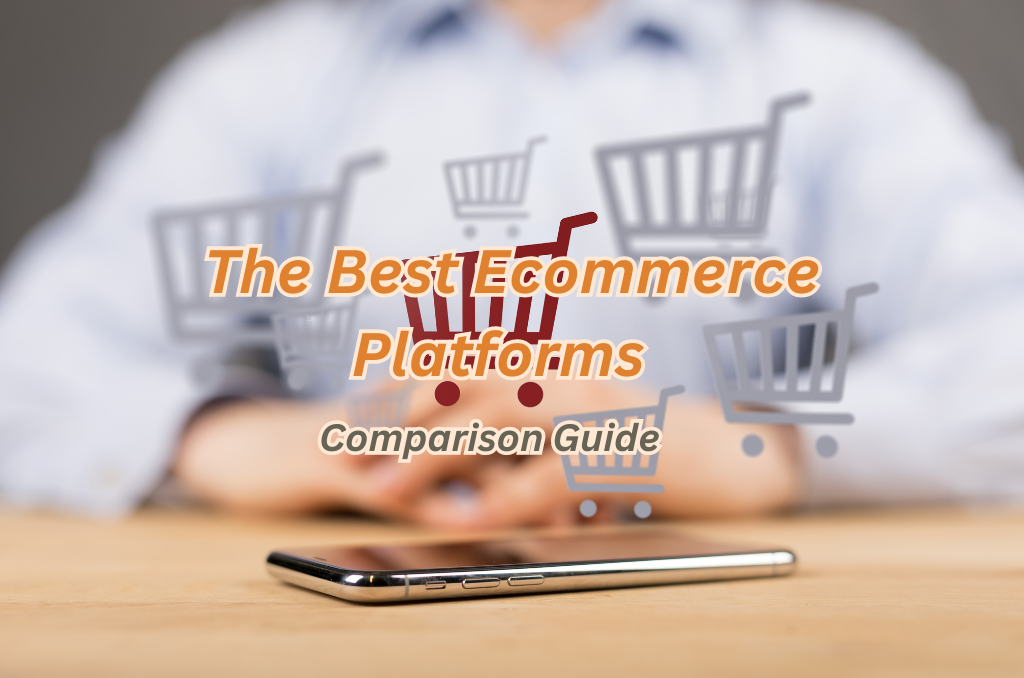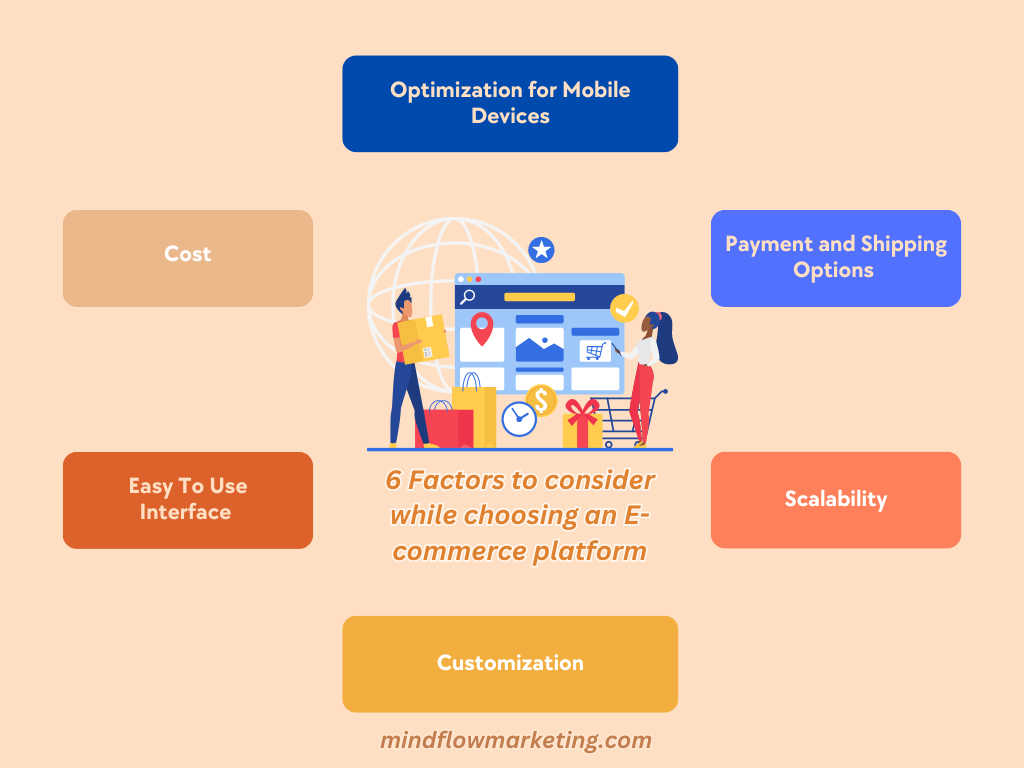Welcome to our comprehensive guide for comparing the top e-commerce solutions of 2023. This resource is here to help you make an informed decision when selecting the ideal platform for your online business. In today’s digital landscape, choosing the right e-commerce solution is crucial for maximizing revenue and ensuring seamless customer experiences.
This guide will delve into various aspects of popular e-commerce platforms such as Shopify, BigCommerce, Adobe Commerce, and WooCommerce. Each offers unique features that cater to different needs – from selling capabilities and real-time inventory control to ease-of-use rankings.
Stay tuned for valuable insights that can elevate your online store presence in 2023!

More Resources :
How to Choose an E-commerce Platform ?
Let us begin at the beginning. What factors should you consider when selecting an e-commerce platform?

The first and most important consideration is, of course, the price. If you’re starting with e-commerce, you probably don’t have a large budget. But don’t be concerned! There are free or low-cost e-commerce platforms available, and even with some limitations, you can get the job done.
According to the Pew Research Centre, roughly three-quarters of Americans purchase items online using smartphones.
That is why the e-commerce platform you select must be mobile-friendly!
Payment and shipping options are important to consider because they can make or break your sales: offering various payment and shipping options can broaden your customer base and allow you to expand your e-commerce internationally.
If everything goes as planned and orders begin to flow, you’ll also need a scalable platform to keep up with the volume of traffic and orders.
Another important consideration is how much you can customize your online store. Customization is important because it allows you to make your store your own.
E-commerce platforms differ: some provide basic customization options, whereas others provide more advanced features to create a unique online store.
Finally, there is a user-friendly interface. This is an important consideration to remember because it can significantly impact the overall user experience and customer satisfaction.
A good user interface should be intuitive, simple, and easy to use, allowing users to find what they’re looking for quickly and easily.
Top E-commerce Platforms Overview
This section will provide an overview of the top e-commerce platforms available, such as Shopify, BigCommerce, Adobe Commerce, and WooCommerce. These platforms cater to different preferences like affordability or customization levels – making it easier to find the perfect fit for your online store needs.
#1. Shopify: Excels At Selling Capabilities
The leading choice among business owners, Shopify is known for its user-friendly interface and powerful selling features. With many customizable templates and effortless integration with widely-used payment portals, Shopify enables users to launch an eCommerce store swiftly.
Additionally, their extensive app marketplace allows users to add functionality as needed.
Pros and Cons of Shopify
Pros of Shopify
Cons of Shopify
More Resources :
#2. BigCommerce: Versatile Overall Winner
Offering a comprehensive suite of tools designed specifically for e-commerce businesses, BigCommerce stands out as a versatile platform that can accommodate various types of stores. Their robust feature set, from small startups to large enterprises, includes advanced SEO tools, flexible product management options, and multi-channel sales support.
Pros and Cons of Bigcommerce
Pros of BigCommerce
Cons of BigCommerce
#3. Adobe Commerce: Real-time Inventory Control
Formerly known as Magento Commerce, Adobe Commerce is a powerful e-commerce platform that offers real-time inventory control and advanced marketing features. Its open-source nature allows for extensive customization, making it an ideal choice for businesses with unique requirements or those looking to scale rapidly.
Pros and Cons of Adobe Commerce
Pros of Adobe Commerce
Cons of Adobe Commerce
In conclusion, while Adobe Commerce offers many advantages over traditional methods, such as increased efficiency and cost savings, one must weigh both pros & cons carefully before investing in getting maximum value from their investment moving forward into 2021 & beyond!
#4. WooCommerce: Tops Ease-of-use Rankings
As the most popular e-commerce plugin for WordPress, WooCommerce boasts a user-friendly interface and seamless integration with the world’s leading content management system. With thousands of plugins in its ecosystem, users can easily extend their store’s functionality to meet specific needs. WooCommerce offers a variety of payment gateways and shipping options to choose from.
Security can be a concern with WooCommerce, as there have been reports of vulnerabilities within the codebase. This is often due to improper maintenance practices by owners, such as not updating core files regularly, leaving them open to malicious attacks from hackers looking to access sensitive customer data stored in databases.
Pros and Cons of WooCommerce
Pros of WooCommerce
Cons of WooCommerce
Overall, the top e-commerce platforms offer a range of features to suit different businesses. Weighing up the advantages and disadvantages of various e-commerce platforms is essential when selecting one, especially regarding affordability and integration options.
Value-for-Money Offerings and Integration Capabilities
If you’re looking for ecommerce platforms that offer excellent value for money, Prestashop and Ecwid are two options worth considering. Both platforms provide a range of features at competitive prices, making them ideal choices for businesses on a budget.
#5. Prestashop’s Unbeatable Value with Free Features
Prestashop is an open-source platform that offers free domain registration and SSL certificate award-winning templates. Thanks to Prestashop’s free domain registration and SSL certificate award-winning templates, you can start your ecommerce journey without worrying about any initial expenses.
In addition to its affordable pricing structure, Prestashop boasts a wide array of built-in features, such as multi-language support, multiple payment gateway integration, and advanced SEO tools designed to help you grow your business quickly.
#6. Seamless Integration with Ecwid
Much like Prestashop, Ecwid is another value-for-money ecommerce platform that allows for seamless integration into existing websites or social channels without requiring any coding knowledge. This makes it an excellent choice for businesses looking to add ecommerce functionality to their current website or expand their online presence across multiple platforms.
In summary, Prestashop and Ecwid offer outstanding value-for-money options with powerful features catering to various business needs. Choosing one of these affordable ecommerce platforms allows you to grow your online store while keeping costs low.
Flexible Selling Options Across Multiple Currencies or Languages
Reaching a wider audience by expanding your online store to include multiple currencies and languages can help increase sales. An ecommerce platform with flexible selling options across multiple currencies and languages is essential to reach a global audience successfully.
This section will discuss some of the top platforms offering these features.
#7. Weebly’s Flexibility for Global Markets
Weebly offers a simple yet powerful website builder with built-in ecommerce capabilities. It allows you to create an online store in multiple languages using third-party apps like Weglot or Bablic. Additionally, Weebly supports various payment gateways that accept different currencies – making it easier for international customers to shop at your store without hassle.
#8. Nexcess StoreBuilder
If you believe WooCommerce is the right ecommerce platform for your company but need some assistance getting started, Nexcess StoreBuilder can help. It is a service provider built on WooCommerce rather than an ecommerce platform. It combines managed hosting, the WooCommerce WordPress plugin, and additional plugins and tools to make building and maintaining a store easier for new ecommerce business owners.
#9. Big Cartel: Catering to Artists Worldwide
Big Cartel, specifically designed for artists and creators looking to sell their work online, supports multiple currencies. Though limited in language support, Big Cartel allows for manual translation of store content – making it a viable option for small businesses targeting specific international markets.
#10. Zyro: A New Contender with Global Reach
Zyro is an up-and-coming ecommerce platform that offers built-in multi-currency and language support. With AI-driven tools like the AI Writer and AI Heatmap, Zyro helps you create engaging content in multiple languages while optimizing your online store’s layout to improve conversion rates across different regions.
#11. Squarespace: Aesthetically Pleasing & Lightweight
Squarespace, a SaaS website platform provider, is the world’s second-largest eCommerce platform market share (nearly 18%). SquareSpace, known as the go-to platform for creatives, makes it simple to create an eye-catching storefront. Squarespace is an affordable solution for branded online stores, with beautiful, modern templates and the ability to regularly change your store’s style.
#12. Square
If you want to combine your online presence with brick-and-mortar sales, Square provides an all-in-one solution. It supports multiple currencies and integrates seamlessly with popular ecommerce platforms like Weebly or WooCommerce, allowing you to manage both online and offline sales efficiently from one dashboard.
Incorporating flexible selling options such as multiple currencies and languages into your ecommerce strategy can significantly enhance your business’ global reach. Choosing the right platform tailored to these needs will enable you to cater to customers worldwide while maximizing revenue potential.
Flexible selling options across multiple currencies or languages allow businesses to reach a wider customer base and maximize their profits. Nevertheless, businesses must contemplate the advantages and disadvantages of cloud-based systems and headless/open-source ecommerce tools before selecting the most suitable platform for their requirements.
Cloud-based vs. Self-hosted Solutions & Headless/Open-source Ecommerce Solutions
In this section, we will explore the distinctions between cloud-based and self-hosted ecommerce solutions and analyze the potential of headless or open-source platforms. It is essential to weigh the pros and cons of each option to determine which best meets your business needs.
Pros and Cons of Cloud-based Solutions
Cloud-based ecommerce platforms, such as Shopify and BigCommerce, offer a range of features that make them an attractive choice for many businesses.
Some key advantages include the following:
However, there are also some potential downsides to consider:
Pros and Cons of Headless/Open-source Ecommerce Platforms
Headless and open-source ecommerce solutions, such as WooCommerce or Magento, allow businesses to create a fully customized online store. Some notable advantages include the following:
However, these benefits come with some trade-offs:
Frequently Asked Questions About The Best Ecommerce Platforms Comparison Guide (2023).
Conclusion
In conclusion, the best ecommerce platforms comparison guide (2023) has provided an overview of the top solutions regarding value-for-money offerings and integration capabilities. Depending on your business needs, there are various options to choose from, such as cloud or self-hosted solutions, headless/open source technologies, or flexible selling across multiple currencies and languages. With this knowledge, you can confidently select the ideal platform for your ecommerce store.